FREE CHRISTMAS SHIPPING ALL DECEMBER

How to body surf
by WAW Handplanes
"If you can swim you can bodysurf"
Introduction.
Bodysurfing is an incredibly accessible sport. It offers all the thrills of surfing, but the only skill required to get started is the ability to swim. This means whether you’re just starting out or you’re a seasoned waterman/women, bodysurfing is for you.
We’ve put together this how to bodysurf tips and tricks guide for everyone. Depending on where you are in your bodysurfing journey simply skip to the section thats relevant to you.
In this guide we will cover:
Bodysurfing, A Beginners Guide.
1.1 Equipment selection
1.2 Where to bodysurf
1.3 How to catch a wave
1.4 How to ride a wave
1.5 Introducing a handplane.
Intermediate Bodysurfing
2.1 Equipment selection
2.2 Where to bodysurf
2.3 Bodysurfing across the wave
2.4 Making the drop
2.5 Maintaining a high line
2.6 Pulling into close out barrels
2.7 Basic bodysurfing tricks.
Advanced Bodysurfing
-Where to bodysurf
-Advanced bodysurfing tricks
-Making a barrel
Body surfing, a beginners guide.
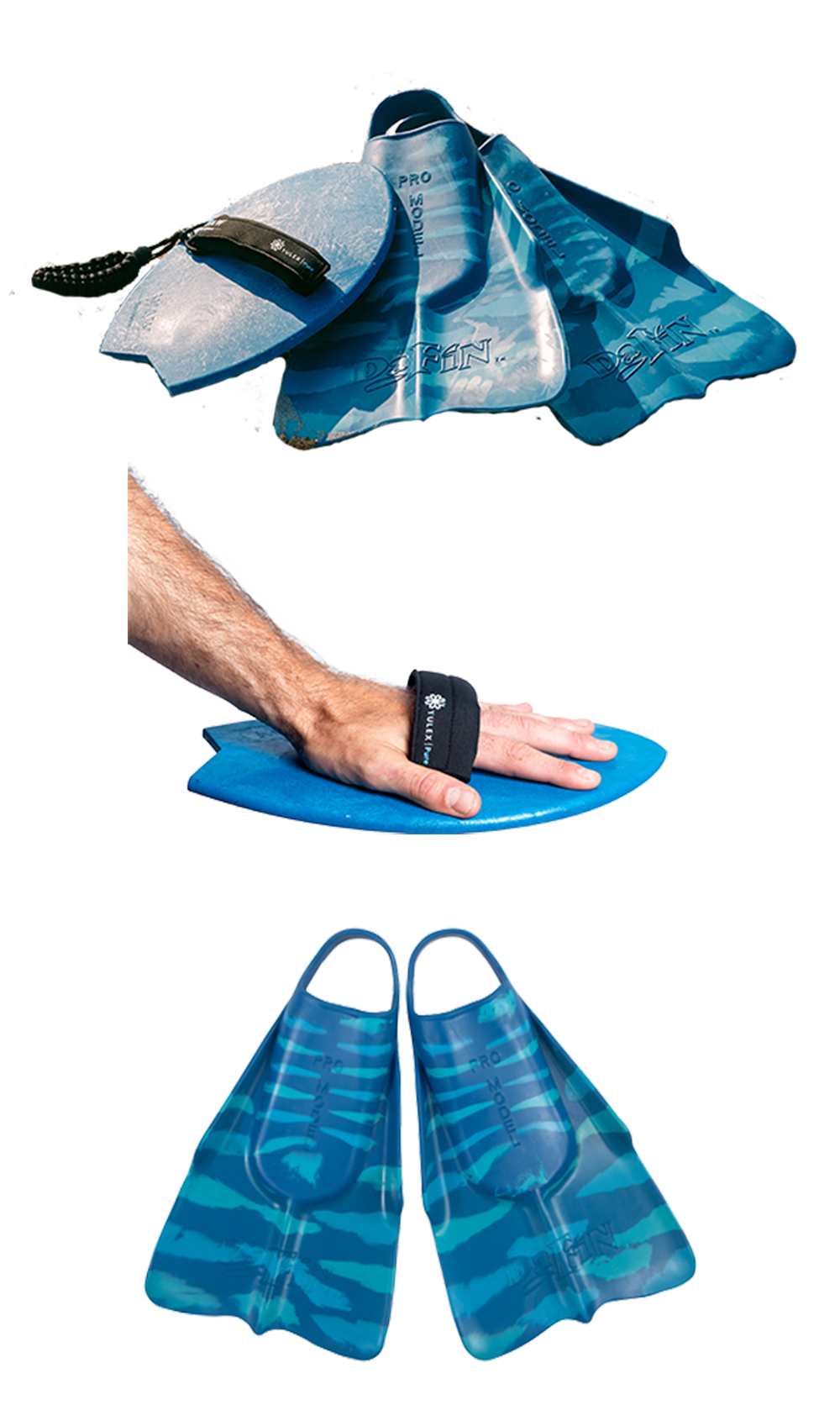
Handplanes and Swim Fins
1.1 Equipment Selection.
In its purest form body surfing is the art of surfing a wave with no equipment at all, which is entirely possible and very fun. There are a few equipment choices you can equip yourself with however that are designed to enhance your body surfing experience. The equipment options we suggest in this article ultimately allow the bodysurfer to catch waves easier, ride them faster, longer and with more control than the no equipment option.
Handplanes
Handplanes are used to enhance the bodysurfing experience. They are a planing device that is worn on one hand, usually the lead hand, of the bodysurfer. They work by providing lift to the bodysurfer and therefore reducing drag, and increasing speed.
Body Surfing Fins
Body surfing swim fins give the bodysurfer the swimming power required to catch a wave. They are usually shorter than standard snorkelling and diving fins and are designed to provide short powerful bursts of speed. If you haven’t worn swim fins before than can feel slightly awkward at the start but you soon get used to them. However, for this reason for this beginner guide we are going to stick with using the handplanes.
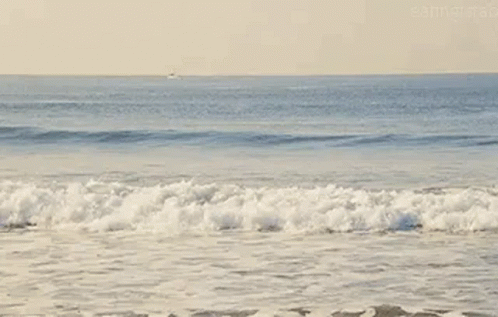
1.2 Where to body surf.
Pick a patrolled beach and choose
any area between the designated swimming flags. Ideally you want a bit of a sandbank with chest high waves breaking into waste deep water. Dont choose anywhere where the waves are above head height or there are strong rips or currents. At this stage you also want to avoid anywhere where the waves are dumping hard onto the bare sand.
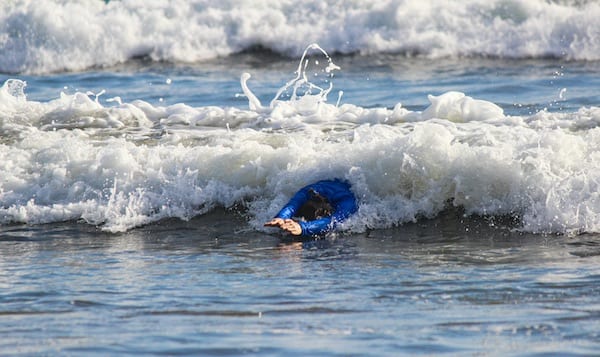
1.3 How to body surf a wave.
Once you’ve selected your location. Wade out to a spot just beyond where the waves are breaking. Ideally this would be in slightly above waist high water. No equipment is required for this firststage. As the wave approaches you turn to face the beach and wait for the wave to reach you. Just before it reaches you (this timing is critical) kick off the sand and dive towards the beach, both arms outstretched, like a diver. NOTE. You’re aiming to remain in the upper level of the water. You don’t want to be diving too deep and risk hitting the sand bank. A good cue is it aim to have your face in the water but not your whole head. From here you can do a couple of swimming strokes for more speed and If the timing was right, you should feel the wave pick you up and push you forward. You will feel the increase in speed. Congratulations this is body surfing!

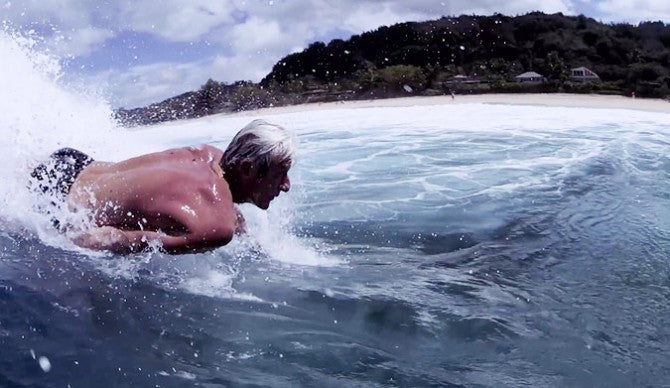
1.4 How to ride the wave.
Once you feel that increase in speed you have 2 options. You can either keep your head down and arms outstretched which will give you a nice streamlined shape for minimal resistance and increased speed, or you can place your arms by your side and lift your chest and head up. This option allows you to see where you are going and offers your chest as a nice planing surface to reduce drag. Just note that this latter option is’nt very good for busy beaches as it gives you little protection from collisions.
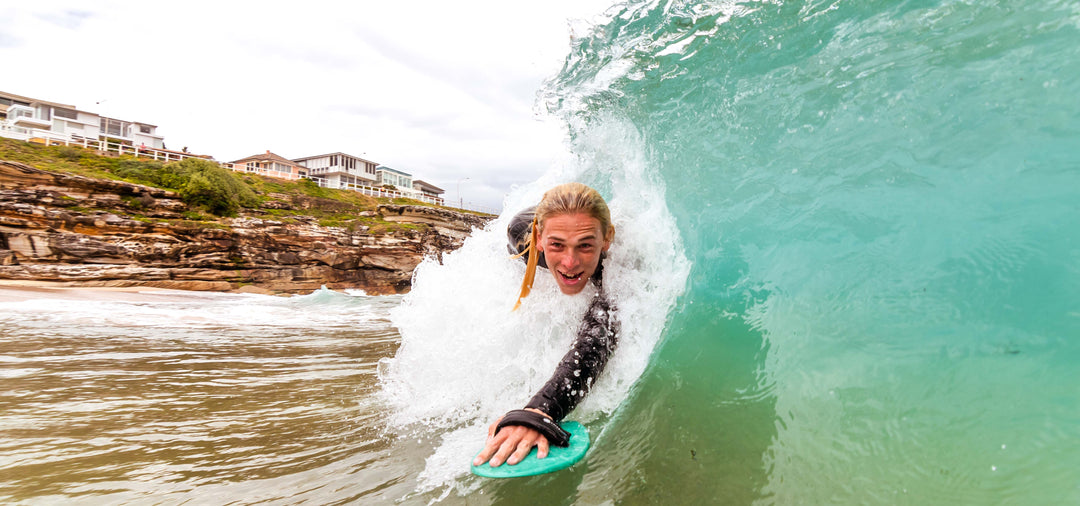
1.5 Introducing a handplane.
Once you’ve mastered the timing
of the above you can introduce a body surfing handplane. Place the handplane on your dominant hand. When you’re diving for your wave plant the handplane on the waters surface out in front of you. NOTE* the handplane only works if it’s on the water, a handplane that’s held above the water will not work. As you jump forward the handplane will start to work straight away. As soon as it starts planing on the waters surface it will start to generate lift. The lift helps bring your chest up onto the water, dramatically reducing your drag. Your chest then helps lift you hips and legs further reducing your drag and maximising your speed. It’s a good idea to practice with
no handplane to begin with as this allows you to focus on the timing of catching a wave with no distractions. Master this, and then introduce the handplane for a dramatic improvement.
Intermediate Body Surfing.
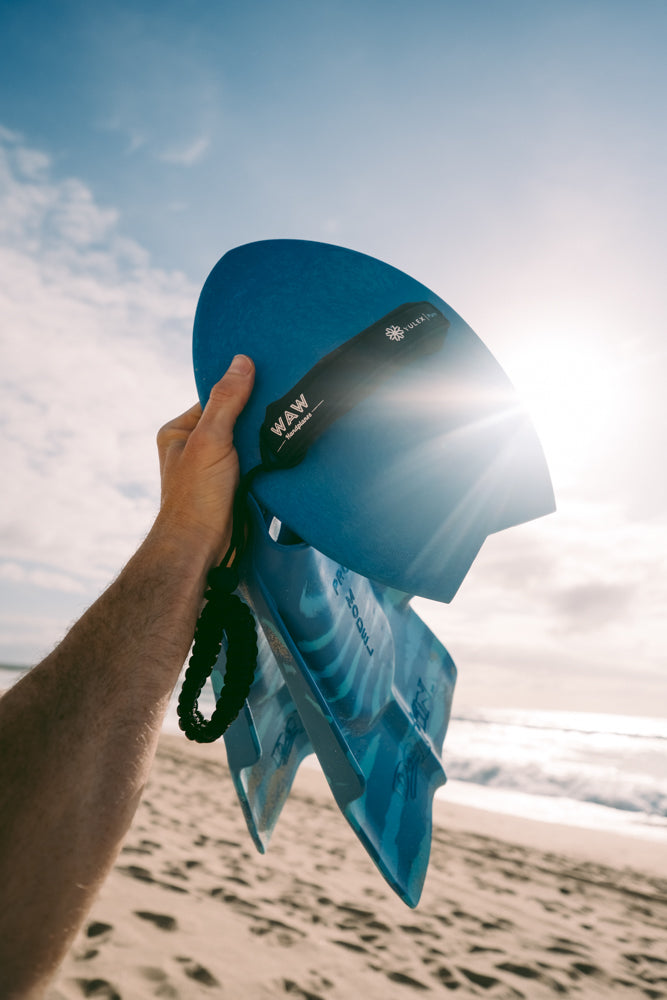
2.1 Equipment selection.
Once you’ve caught a few waves
with the handplane and no fins and your getting comfortable with the timing of catching the smaller waves its time to progress and start seeking some larger unbroken waves. For this, I highly recommend investing in some body surfing fins and some fin savers. As soon as you venture out past your depth, the swim fins become vital in giving you the swimming speed to catch the wave and the fins savers pretect your investment from getting washed off your feet in a wipeout. There a few very strong swimmers who opt to wear no fins but 99% of bodysurfers, including world champions, wear fins. Here at WAW we back performance and with that, we would highly recommend looking into DafINs, Yuccas, Vipers, Stealths and DMC swim fins as your go to fin brands.
Combine these swim fins with your handplane and swimmers and you’re all set.
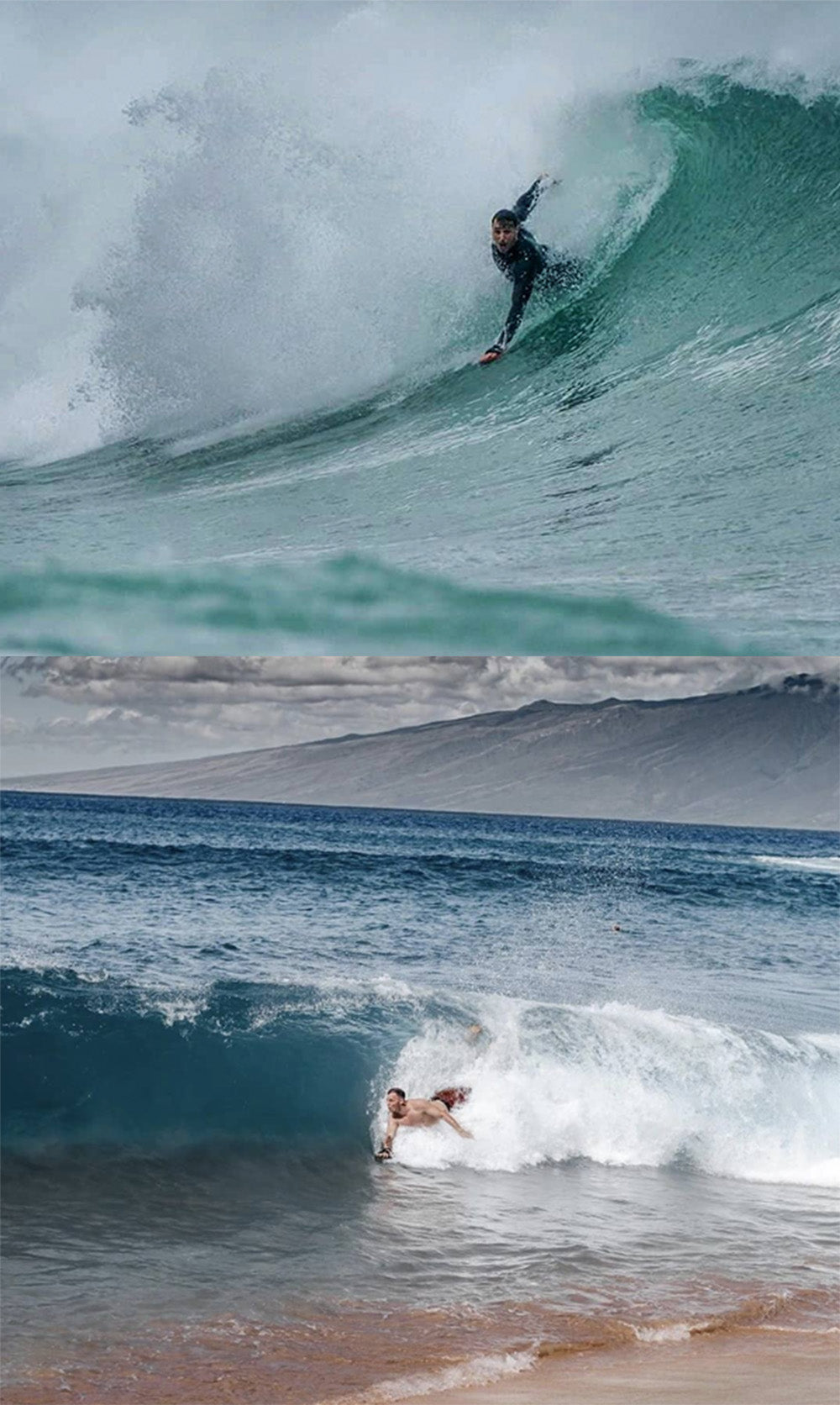
Subtitle
2.2 Where to body surf.
At an intermediate level of body surfing you want be seeking waves that are either ‘out the back’ as in beyond the point of where the waves are breaking, or in the shore break, where the waves are crashing into shallow water. Being out the back will allow you catch waves and
ride them for a long time, being in the shore break will give you a good chance of finding yourself a barrel.
Out the Back
When out the back look for where the surfers are and aim to sit just inside of them (closer to the beach) as a bodysurfer you’ll be able to catch waves at the last second, so if its busy day you’ll be looking to pick up the waves that the make it through the surfers line up unridden. If there are no surfers out (note* never surf alone) try looking for a stretch of beach that offers rolling waves with a steepish open face, as in waves that break left or right but not all at once. These waves will give you the best chance of a nice long ride.
Shore break.
Here you are looking for an area where the waves are close to shore, steep and crashing into shallow water. This type of body surfing should be approached with caution as it can be dangerous if done incorrectly, but the rewards are great and there many barrels to be had.
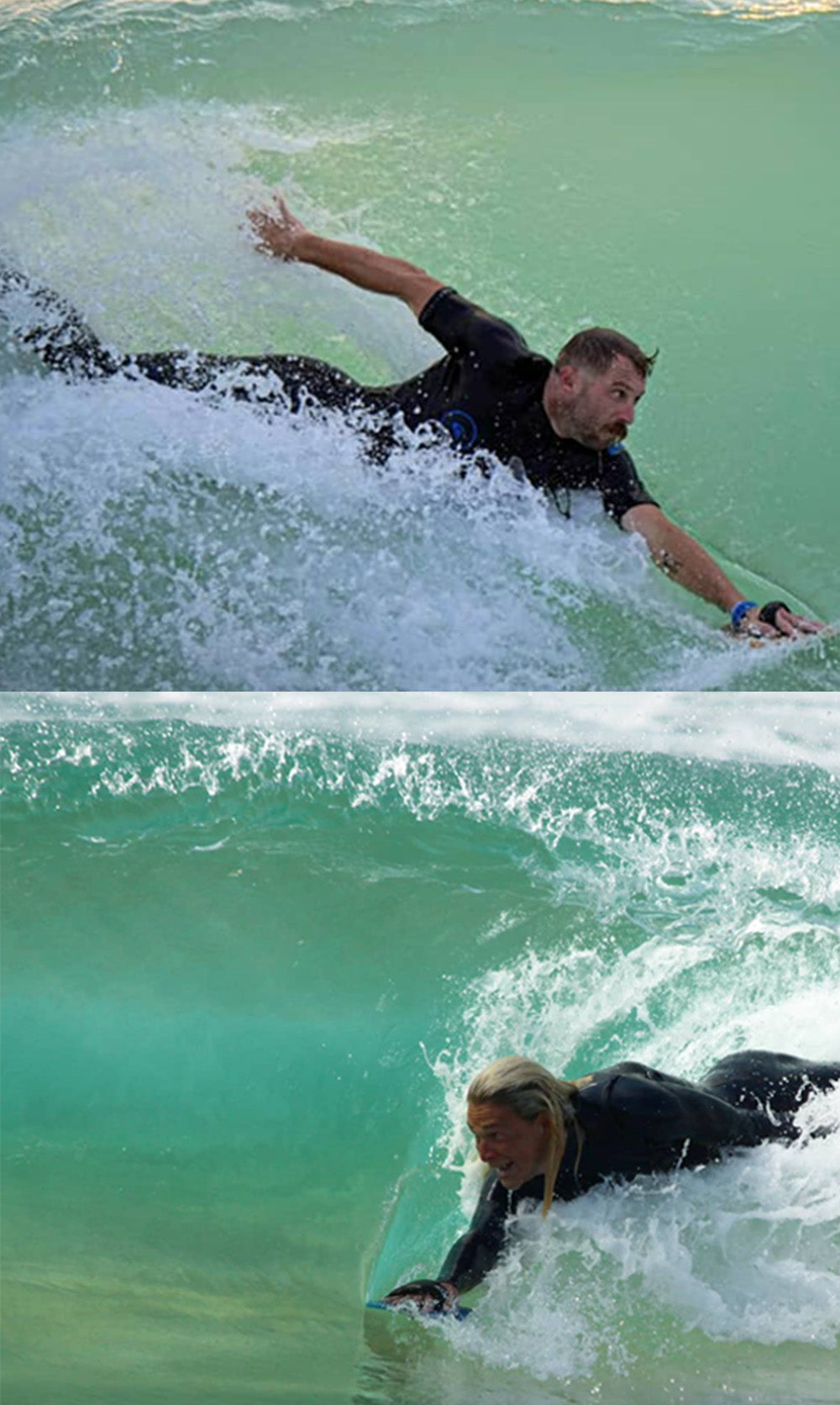
2.3 Body surfing across the wave (trimming).
You’re at a point now where you can regularly catch waves going straight towards the beach. Now you want to progress to body surfing across the open face of the wave, this is known as trimming. The open face is the part of the wave that is not yet broken white water. The goal is to end up in ‘the pocket’ which is the point at which the wave is breaking so you have white water behind you and green open water in front of you.
So, before you catch the wave, try to work out which way it is breaking, is it breaking left or right? Then as the wave approaches you turn to swim towards the beach, as the wave picks you up place your handplane out in front of you and continue to kick with your fins, in fact HOT TIP, don’t stop kicking until you are well and truly on the wave. Once you feel that increase in speed and as you start to ride the wave, begin to angle your body to the direction in which the wave is breaking. A good way to do this is to look in the direction you want to go and try to square your shoulders and handplane to that direction, the rest of your body will follow.
If the wave is steep you may want to start putting your outside arm up and behind you and placing more of your ribs and back into the wave. This will help carve a nice line across the wave. This technique is especially useful for the steeper shore break waves.
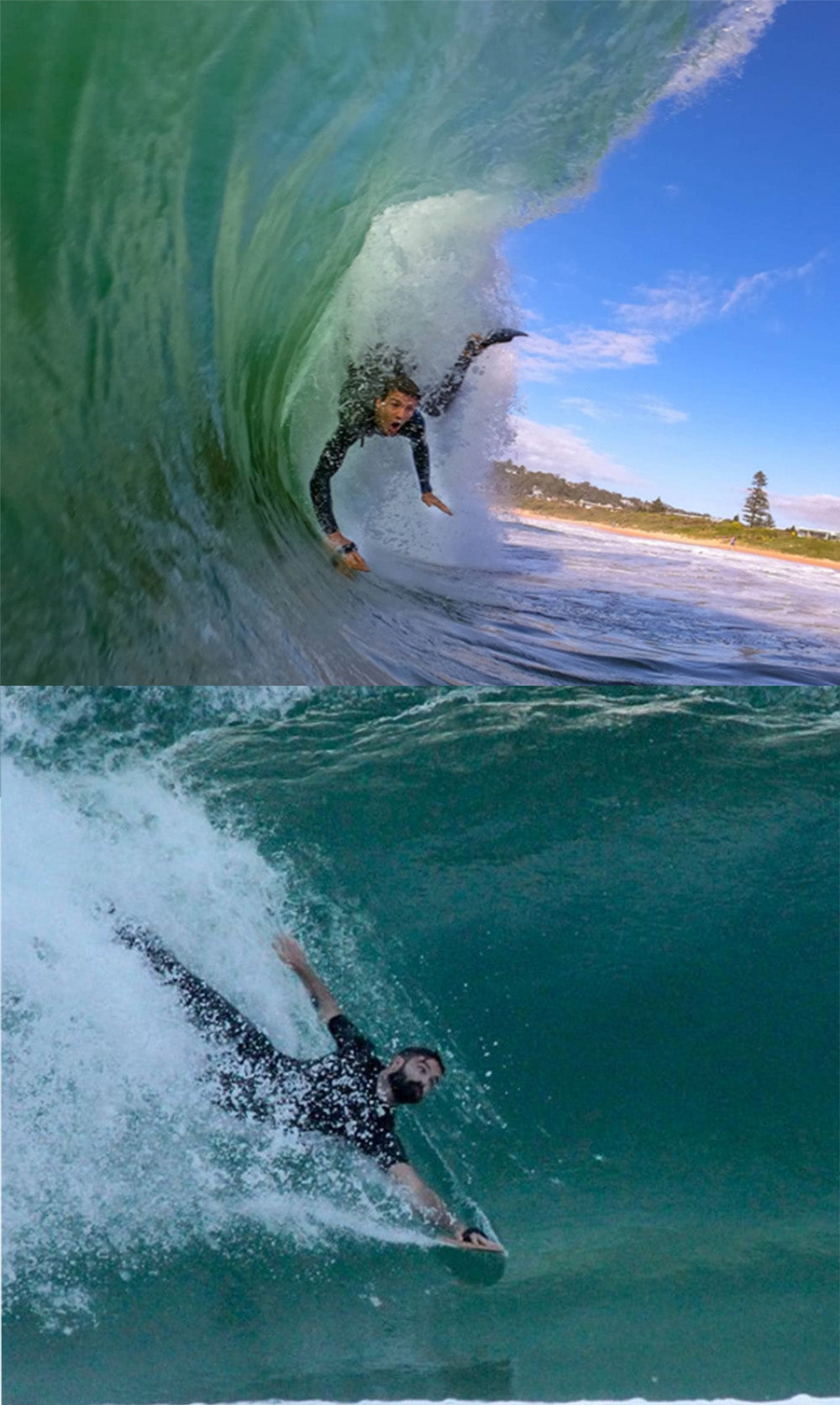
2.4 Making the drop.
Once you start to body surf the larger steeper waves you start to experience a bit of drop as you initially catch the wave. This is when the steepness and speed of the wave creates a momentary disconnection between you and the waves face, essentially a mini air drop. This can be super fun and a great feeling providing you know how to land it so you can continue to ride the wave, otherwise you’ll end up out in the flats in front of the wave where you’ll lose all your speed and quickly be wiped out.
In order to make the drop you need to create a rail edge (think the edge of surfboard) to dig into the waves face as you’re falling. You can do this with your body by digging your hand, arm ribs, hips, legs and feet, from the side of the body that’s the direction you want to go in (i.e right side to surf right) into the waves face. The friction from this slows your decent and allows you to stay connected to the wave. This can also be achieved with your body surfing handplane. Handplanes work very well in this scenario in that they give you a surface area to lean into as your falling down. Providing the handplane is still connected to wave and ideally its rail edge is engaged, it will dramatically stall your decent and allow you to set your line across the wave.

2.5 Maintaining a highline
When body surfing across a wave, the general rule is the higher up on the waves face you are the faster you will go. So, it’s often a good idea to maintain a highline. If you don’t stay high up on the waves face you will end up out in the flats, which is no good, as mentioned above in making the drop.
To maintain this highline you can employ the same techniques as making the drop in that you can use a rail edge, whether that’s your body or the handplane it doesn’t matter. Just so long as anytime you find yourself
slipping down the waves face you engage the rail edge to send you back up the highline.
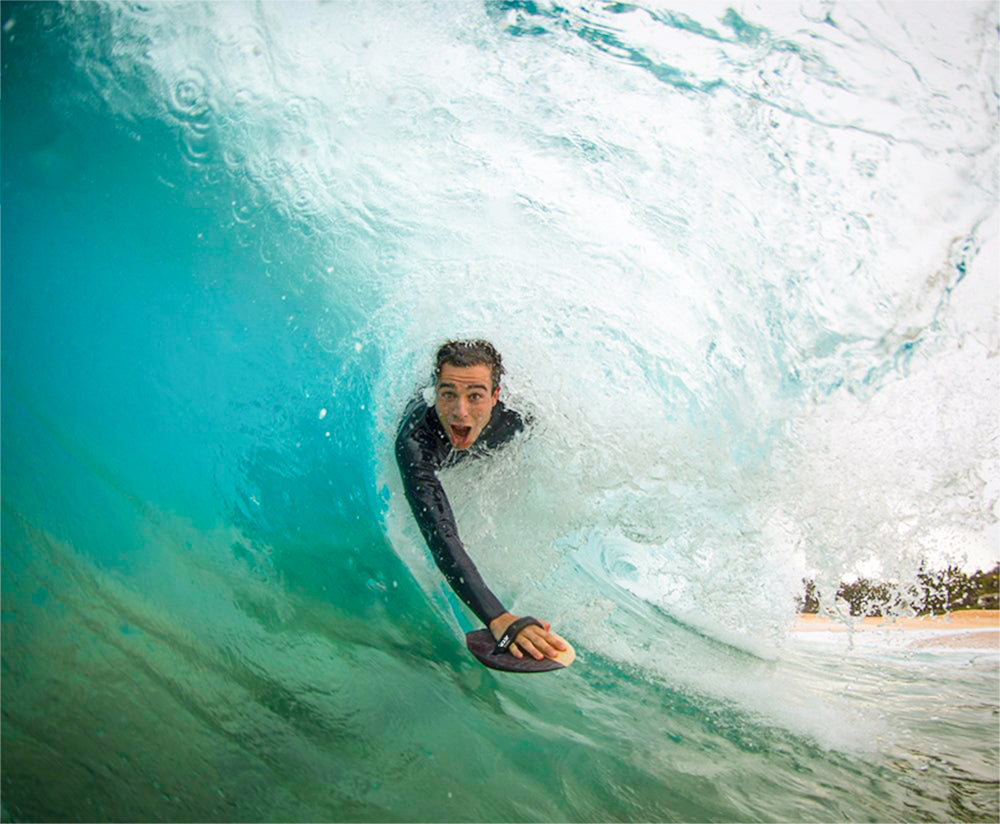
2.6 Pulling into a closeout barrel.
You’ve made the drop, you maintained a high line and you can now see and feel the wave getting steeper and steeper, what do you do? Hold on. If you can maintain your speed and highline there’s a very good chance you’ll sneak inside the barrel that’s inevitably forming behind you. If its not a super steep wave you can lean back into the waves face to maximise the chance of achieving that magnificent view from inside the barrel.
If the waves gets quite steep at the end and the barrel is wide, you may want to drop down the waves face a bit as the time comes, and stall yourself at the bottom by applying the breaks with your hands, handplane or legs, so that the lip of the barrel can throw over the top of you and not throw you with it!
HOT TIP* when the wave starts to barrel a lot of people panic and try to pull off of the wave through fear of the wipe out, but end up getting wiped out even worse. Dont do this, hold on. The safest place to be on a steep wave is inside the barrel!
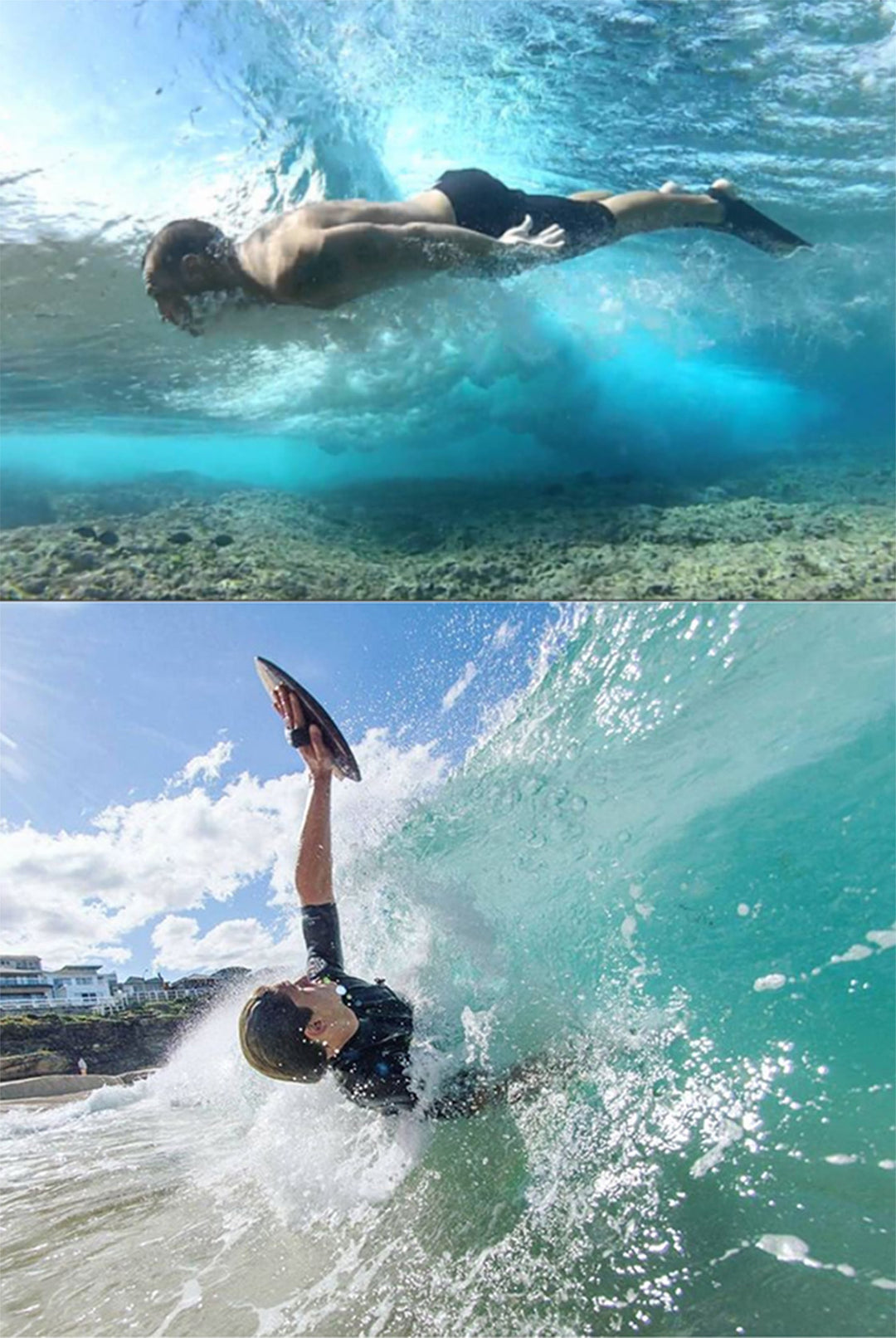
2.7 Basic bodysurfing tricks
Basic body surfing tricks
The first trick you’ll probably learn when body surfing is a spin, whereby the bodysurfer twists their body a full 360 degrees whilst bodysurfing the wave.
Regular spin
This is where the lead hand is thrown up the waves face and over and lands back in the same position it started (clockwise if going left and anti-clockwise going right)
Reverse spin
This is the opposite in that the lead hand extends out towards the bottom of the wave and then up, over and back down the waves face (anticlockwise if going left and clockwise if going right). This is a little more challenging in that the body must twist a bit more to complete the spin.
The tip with both spins is to time the execution for when
you are in a nice fast or steep section of the wave and try it execute the move quickly and cleanly to reduce the chance of catching an arm or handplane in the wave, which would slow you down and may result in you falling off the wave.
Dolphin Start
This is when bodysurfer catches the wave by starting underwater. There is actually a very large amount of energy in the first 12 inches under the waters surface and if you can learn to harness this when catching a wave not only does it look awesome, but it can increase your success rate of catching the wave. To pull this one off you need to make sure you perform it on an unbroken section of the wave and that you keep your body as streamlined a possible whilst under water, this can either be with hands out in front like a diver or arms by your side. Any wayward elbows or angles In the body will create resistance and slow you down which may result in you missing the wave. With regards to kicking you can either two foot kick like a dolphin or stick to regular short powerful freestyle kicks, either way keep kicking until your well and truly on the wave.
Bodysurfing Spin
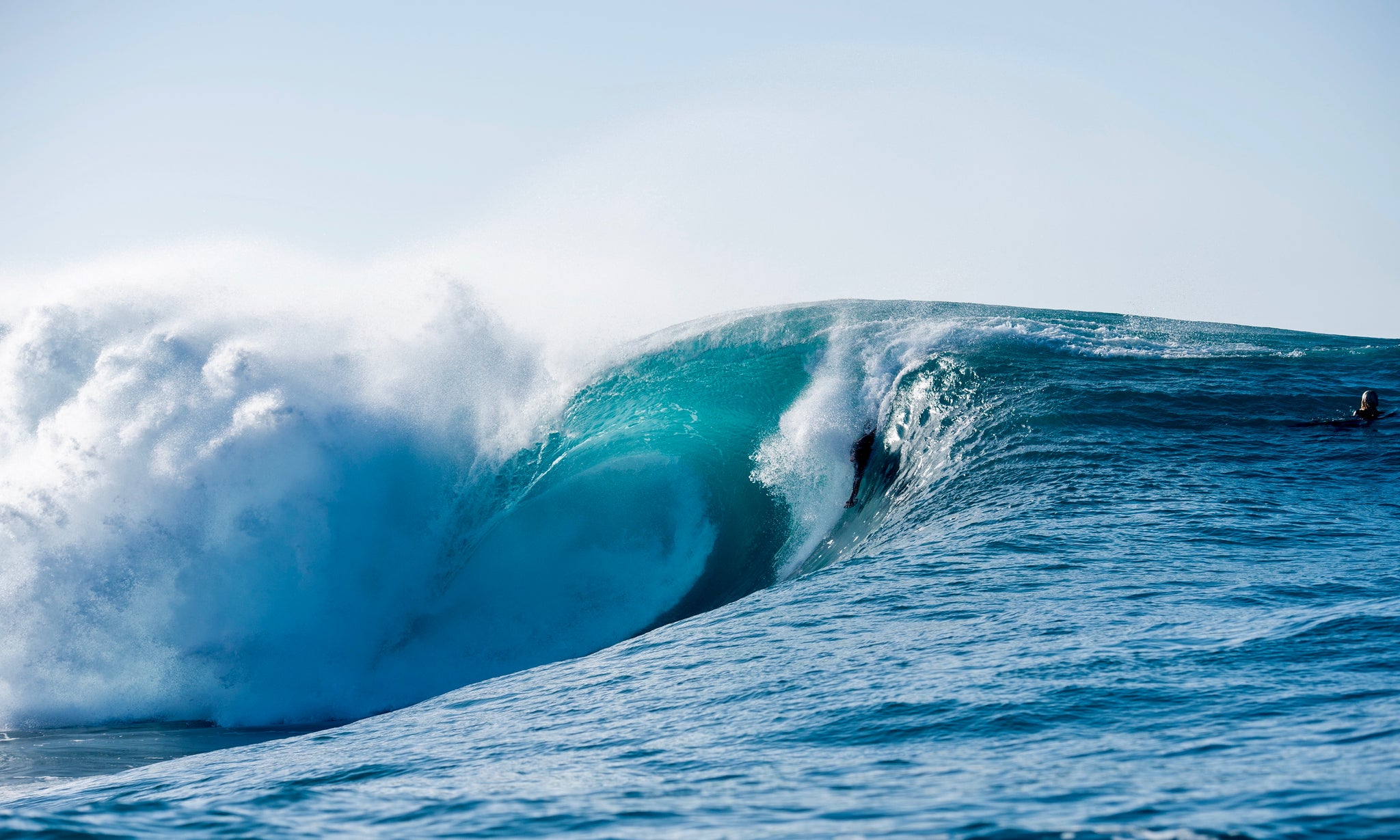
Sign up to our mailing list
About us
WAW Handplanes Copyright 2022
